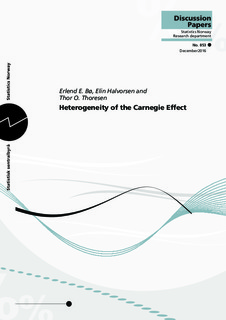Heterogeneity of the Carnegie Effect
Working paper
Permanent lenke
http://hdl.handle.net/11250/2477835Utgivelsesdato
2016-12-01Metadata
Vis full innførselSamlinger
- Discussion Papers [1002]
Originalversjon
https://doi.org/10.3368/jhr.54.3.0915.7366R1Sammendrag
The Carnegie effect (Holtz-Eakin, Joualfaian and Rosen, 1993) refers to the idea that inherited wealth harms recipient’s work efforts, and possesses a key role in the discussion of taxation of intergenerational transfers.
However, Carnegie effect estimates are few, reflecting that such effects are hard to trace in data. Most previous studies have relied on data from limited size sample surveys. Here we use information from a rich administrative data set covering the entire Norwegian population, which makes it possible to undertake a detailed examination of the Carnegie effect, including how it varies across groups of recipients. The estimation results show significant reductions in labor supply for recipients of large inheritances, in the range from 7 to 10 percent in the first six years after the transfer. Moreover, we find that the Carnegie effects differ according to the size of the transfer, the age of the recipients, the recipient’s
